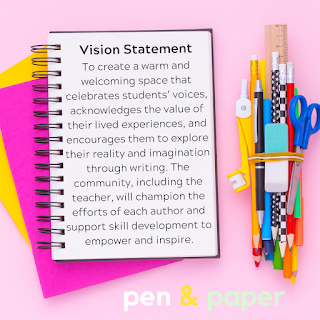The careful consideration of the learning space has a positive impact on education outcomes and to this end this research and reflection has given me pause to learn and consider what can be changed to better meet student needs in both the physical and online environments (Ellis et al., 2018, p. 4). If drawing on the classroom design process of Todd & Wiggs (2016, p. 6) a vision statement for the space could be:
The creation of designated space for Pen & Paper in a physical location in the library is something I have found difficult due to competing interests and perceived ownership of the space which means it is neither aesthetically pleasing or in any way efficient (Todd & Wiggs, 2016, p. 3). For this vision to be enacted the physical space needs to be an area that is permanently allocated, where materials can be stored, students can sit comfortably, and there is some safety in the structure, so students know exactly where to go so they are not faced with the arduous and stressful task of searching for the group. Ideally, there will be writing resources such as dictionaries, rhyming dictionaries, magnetic poetry, alongside the different types of paper and writing implements, available for students and displays that may inspire which could also be replicated in the online space (Todd & Wiggs, 2016, p. 3).
While I have noted limitations in the Google Classroom I have established, I do have greater carriage over the online environment which will certainly take the place of the physical for the time being. While there is access to several Learning Management Systems (Google Suite, Microsoft Office365) via the NSW Department of Education many writing based apps, and blogging platforms are blocked and students cannot access them when using school computers or Wi-Fi. I need to investigate other options for authentic publishing in order to provide more opportunities for students to write and be read by a wider audience (Brown & Long, 2006, p. 126). Google Classroom serves to connect the community and students are able to post their writing and engage in feedback processes but when considering the resources provided to students, in acknowledgement of ‘beauty’ being a human need, there needs to be a space to store and share resources in a visually appealing manner which could be fulfilled by Google Sites and as an extension some interactivity provided by another tool in the Google Suite, such as Jam Board (Todd & Wiggs, 2016, p. 3).
The level of interactivity needs further consideration as engagement levels will not increase without the development and maintenance of the community (Brown & Long, 2006, p. 117). An immersive environment employing a diverse range of online tools is extremely effective for language learning and these tools will increase the effectiveness of the learning that occurs in the extra-curricular learning space (Alexander et al., 2013, p. 53). If the learning space is going to be at all useful and inspiring for student writers there is work to be done.

No comments:
Post a Comment